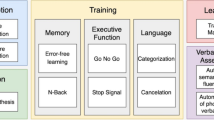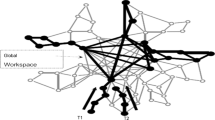Abstract
We present a project to design of the simplified model of thinking located in a little-explored field between neurobiology and psychology. While neurobiology in the incredibly complex microscopic system is dedicated to the structures and signals at the molecular level and the psychology is committed at the opposite extreme with highly sophisticated, they are very abstract and, therefore, difficult to grasp these wholes. There is a vast space between these two extremes. From the perspective of the inherent observers, it is investigable without overcoming the complexity of both points of interest. The primary goal of this research is to construct a multi-layer analog configuration space, the Electronic Equivalent of Consciousness (ECC), wherein the signals have the same properties (bioelectrical) as in the human brain.
Faculty of Electrical Engeneering, Czech Technical University in Prague, Czechia.
Access this chapter
Tax calculation will be finalised at checkout
Purchases are for personal use only
Similar content being viewed by others
References
Almási, A.D., Woźniak, S., Cristea, V., Leblebici, Y., Engbersen, T.: Review of advances in neural networks: neural design technology stack. Neurocomputing 174, 31–41 (2016)
Aylett, M., Turk, A.: The smooth signal redundancy hypothesis: a functional explanation for relationships between redundancy, prosodic prominence, and duration in spontaneous speech. Lang. Speech 47(1), 31–56 (2004)
Bahrick, L., Lickliter, R.: Intersensory redundancy guides attentional selectivity and perceptual learning in infancy. Dev. Psychol. 36(2), 190–201 (2000). https://doi.org/10.1037//0012-1649.36.2.190
Bahrick, L., Lickliter, R.: Intersensory redundancy guides early perceptual and cognitive development. In: Kail, R.V. (ed.) Advances in Child Development and Behavior, vol. 30, pp. 153–187. Elsevier, Boston (2002)
Bahrick, L.E., Lickliter, R., Castellanos, I., Todd, J.T.: Intrasensory redundancy facilitates infant detection of tempo: extending predictions of the intersensory redundancy hypothesis. Infancy 20(4), 377–404 (2015). https://doi.org/10.1111/infa.12081. https://onlinelibrary.wiley.com/doi/abs/10.1111/infa.12081
Benka, T., Havranek, M., Hejtmanek, M., Jakovenko, J., Janoska, Z., Marcisovska, M., Marcisovsky, M., Neue, G., Tomasek, L., Vrba, V.: Characterization of pixel sensor designed in 180 nm SOI CMOS technology. J. Instrum. 13(1), C01025–C01025 (2018)
Cabibihan, J., Joshi, D., Srinivasa, Y.M., Chan, M.A., Muruganantham, A.: Illusory sense of human touch from a warm and soft artificial hand. IEEE Trans. Neural Syst. Rehabil. Eng. 23(3), 517–527 (2015). https://doi.org/10.1109/TNSRE.2014.2360533
Chandra, B., Sharma, R.K.: Deep learning with adaptive learning rate using laplacian score. Expert Syst. Appl. 63, 1–7 (2016). https://doi.org/10.1016/j.eswa.2016.05.022. http://www.sciencedirect.com/science/article/pii/S0957417416302470
Crochet, S., Lee, S.H., Petersen, C.C.: Neural circuits for goal-directed sensorimotor transformations. Trends Neurosci. 42(1), 66–77 (2019). https://doi.org/10.1016/j.tins.2018.08.011. http://www.sciencedirect.com/science/article/pii/S0166223618302364
Dovhij, V., Holota, V., Kogut, I.: Architecture development and elements simulation of analytical microsystem-on-chip with “silicon-on-insulator” structures. In: 2016 13th International Conference on Modern Problems of Radio Engineering, Telecommunications and Computer Science (TCSET), pp. 368–372 (2016)
Drukarch, B., Holland, H.A., Velichkov, M., Geurts, J.J.G., Voorn, P., Glas, G., de Regt, H.W.: Thinking about the nerve impulse: a critical analysis of the electricity-centered conception of nerve excitability. Prog. Neurobiol. 169, 172–185 (2018)
Duan, S., Hu, X., Dong, Z., Wang, L., Mazumder, P.: Memristor-based cellular nonlinear/neural network: design, analysis, and applications. IEEE Trans. Neural Netw. Learn. Syst. 26(6), 1202–1213 (2014)
Futagi, Y.: Eye-hand-mouth coordination in the human newborn. Pediatr. Neurol. 75, 43–47 (2017)
Golovin, M.S., Balioz, N.V., Krivoschekov, S.G., Aizman, R.I.: Integration of functional, psychophysiological, and biochemical processes in athletes after audiovisual stimulation. Hum. Physiol. 44(1), 54–59 (2018)
Graham, S.A., Depp, C.A.: Artificial intelligence and risk prediction in geriatric mental health: what happens next? Int. Psychogeriatr. 31(7), 921–923 (2019). https://doi.org/10.1017/S1041610219000954
Helmbrecht, T.O., dal Maschio, M., Donovan, J.C., Koutsouli, S., Baier, H.: Topography of a visuomotor transformation. Neuron 100(6), 1429–1445.e4 (2018)
Hickey, C., Peelen, M.: Neural mechanisms of incentive salience in naturalistic human vision. Neuron 85(3), 512–518 (2015). https://doi.org/10.1016/j.neuron.2014.12.049. http://www.sciencedirect.com/science/article/pii/S0896627314011581
Hitier, M., Sato, G., Zhang, Y.F., Zheng, Y., Besnard, S., Smith, P.F., Curthoys, I.S.: Anatomy and surgical approach of rat’s vestibular sensors and nerves. J. Neurosci. Methods 270, 1–8 (2016)
Holland, S.: Artificial intelligence, education and music: the use of artificial intelligence to encourage and facilitate music composition by novices (1989)
Huang, M.H., Rust, R., Maksimovic, V.: The feeling economy: managing in the next generation of artificial intelligence (AI). Calif. Manag. Rev. 61(4), 43–65 (2019). https://doi.org/10.1177/0008125619863436
Huda, R., Goard, M.J., Pho, G.N., Sur, M.: Neural mechanisms of sensorimotor transformation and action selection. Eur. J. Neurosci. 49(8), 1055–1060 (2019)
Iurlaro, M., von Meyenn, F., Reik, W.: Dna methylation homeostasis in human and mouse development. Curr. Opin. Genet. Dev. 43, 101–109 (2017)
Jacobs, L.F.: Of space and smell: the strange evolution of the human nose. In: HRI 2017: Proceedings of the 2017 ACM/IEEE International Conference on Human-Robot Interaction, pp. 350–351. Association for Computing Machinery, New York (2017 )
Jang, S.H., Kwon, H.G.: The ascending reticular activating system from pontine reticular formation to the hypothalamus in the human brain: a diffusion tensor imaging study. Neurosci. Lett. 590, 58–61 (2015)
Ji, M., Su, X., Su, X., Chen, Y., Huang, W., Zhang, J., Gao, Z., Li, C., Lu, X.: Identification of novel compounds for human bitter taste receptors. Chem. Biol. Drug Des. 84(1), 63–74 (2014)
Lazovic, B., Zlatkovic Svenda, M., Durmic, T., Stajic, Z., Duric, V., Zugic, V.: The regulation role of carotid body peripheral chemoreceptors in physiological and pathophysiological conditions. Med. pregl. 69(11–12), 385–390 (2016)
Lima, P.M., Ford, N.J., Lumb, P.M.: Computational methods for a mathematical model of propagation of nerve impulses in myelinated axons. Appl. Numer. Math. 85, 38–53 (2014)
Liston, A., Carr, E., Linterman, M.: Series: lifetime immunity shaping variation in the human immune system. Trends Immunol. 37(10), 637–646 (2016)
Manson, G., Blouin, J., Kumawat, A., Crainic, V., Tremblay, L.: Rapid online corrections for upper limb reaches to perturbed somatosensory targets: evidence for non-visual sensorimotor transformation processes. Exp. Brain Res. 237(3), 839–853 (2019)
Mayrhofer, J.M., El-Boustani, S., Foustoukos, G., Auffret, M., Tamura, K., Petersen, C.C.H.: Distinct contributions of whisker sensory cortex and tongue-jaw motor cortex in a goal-directed sensorimotor transformation. Neuron 103(6), 1034–1043.e5 (2019)
McCarthy, J.: What has ai in common with philosophy? In: IJCAI, pp. 2041–2044 (1995)
Orioli, G., Bremner, A.J., Farroni, T.: Multisensory perception of looming and receding objects in human newborns. Curr. Biol. 28(22), R1294–R1295 (2018)
Pham, H.L.: Characterisations of von neumann algebras. J. Math. Anal. Appl. 454(2), 542–556 (2017)
Saini, S., Singh, P.: Von neumann stability of modified loop quantum cosmologies. Class. Quantum Gravity 36(10), 105010 (2019)
Sebastian, A., Le Gallo, M., Eleftheriou, E.: Computational phase-change memory: beyond von neumann computing. J. Phys. D-Appl. Phys. 52(44), 443002 (2019)
Sood, S.O.: Emotional computation in artificial intelligence education. In: AAAI (2008)
Sottek, R., Genuit, K.: Models of signal processing in human hearing. AEU - Int. J. Electron. Commun. 59(3), 157–165 (2005). https://doi.org/10.1016/j.aeue.2005.03.016. http://www.sciencedirect.com/science/article/pii/S1434841105000701
Sterne, J., Razlogova, E.: Machine learning in context, or learning from LANDR: artificial intelligence and the platformization of music masterin. Soc. Media + Soc. 5(2), 2056305119847525 (2019). https://doi.org/10.1177/2056305119847525
Tuthill, J.C., Azim, E.: Proprioception. Curr. Biol. 28(5), R194–R203 (2018). https://doi.org/10.1016/j.cub.2018.01.064. http://www.sciencedirect.com/science/article/pii/S0960982218300976
Wu, W., Guo, Z., Zhou, X., Wu, H., Zhang, X., Lian, R., Wang, H.: Proactive human-machine conversation with explicit conversation goals (2019)
Acknowledgments
Research described in the paper was supported by the Czech Technical University grant SGS20/176/OHK3/3T/133 and Nadace Science 21 foundation.
Author information
Authors and Affiliations
Corresponding author
Editor information
Editors and Affiliations
Rights and permissions
Copyright information
© 2020 The Editor(s) (if applicable) and The Author(s), under exclusive license to Springer Nature Switzerland AG
About this paper
Cite this paper
Bernau, L., Paulu, F., Voves, J. (2020). Electronic Equivalent of Consciousness with Elementary Mental Process Model. In: Iliadis, L., Angelov, P., Jayne, C., Pimenidis, E. (eds) Proceedings of the 21st EANN (Engineering Applications of Neural Networks) 2020 Conference. EANN 2020. Proceedings of the International Neural Networks Society, vol 2. Springer, Cham. https://doi.org/10.1007/978-3-030-48791-1_38
Download citation
DOI: https://doi.org/10.1007/978-3-030-48791-1_38
Published:
Publisher Name: Springer, Cham
Print ISBN: 978-3-030-48790-4
Online ISBN: 978-3-030-48791-1
eBook Packages: Computer ScienceComputer Science (R0)




